Sensitivity Analysis of a Regional Nutrient Budget Model for Two Regions with Intensive Livestock Farming in Korea
Abstract
:1. Introduction
2. Materials and Methods
2.1. Regional Nutrient Budget Model (NB-NIER) for the LES
2.2. Data Input
2.3. Equations for Nutrient Budget Model
2.4. Regional Nutrient Budget Model Coefficients
2.5. Sensitivity Analysis
2.5.1. Nutrient Budgets for Sensitivity Analysis
2.5.2. Nutrient Budgets Sensitivity Analysis
3. Results
3.1. Nutrient Budgets for Sensitivity Analysis
3.1.1. Nitrogen Budget
3.1.2. Phosphorus Budget
3.2. Outcomes of Nitrogen Budget Sensitivity Analysis
3.2.1. Outcomes of Sensitivity Analysis of GNS
3.2.2. Outcomes of Sensitivity Analysis of hNS
3.3. Outcomes of Sensitivity Analysis of PS
4. Discussion
4.1. Nutrient Budget Estimation for Sensitivity Analysis
4.2. Nitrogen Budget Sensitivity Analysis
4.2.1. Sensitivity Analysis of GNS
4.2.2. Sensitivity Analysis of hNS
4.3. Sensitivity Analysis of PS
5. Conclusions
Author Contributions
Funding
Acknowledgments
Conflicts of Interest
References
- Lee, D.H. A Sensitivity Analysis for Regional-Based Maximum Nutrient Loading System. Master’s Thesis, Chonnam National University, Kwangju, Korea, February 2016. [Google Scholar]
- Song, J.H.; Kim, C.G.; Heo, D.; Lim, S.J. A Study on the Introduction of Regional Maximum Load System of Livestock Numbers; Korea Rural Economic Institute: Seoul, Korea, 2004; pp. 1–158. [Google Scholar]
- Kim, C.G.; Jung, H.G.; Lim, P.E.; Kim, T.H. Direct for Introducing Total Maximum Nutrient Loading System of Cultivated Land; Korea Rural Economic Institute: Seoul, Korea, 2015; pp. 1–180. [Google Scholar]
- Yoo, S.H.; Ro, H.W.; Choi, W.J. Soil and Water Qualities Affected by Six Decades of Agricultural Paradigm Shift in Korea, The National Academy of Sciences, Republic of Korea, 3rd ed.; The Report on International Academic Exchange and Cooperation: Seoul, Korea, 2012; pp. 3–33. [Google Scholar]
- Lim, D.Y.; Ryu, H.D.; Chung, E.G.; Kim, Y.S.; Lee, J.K. Regional application of the OECD nitrogen budget considering livestock manure compost. J. Korean Soc. Water Environ. 2017, 33, 546–555. [Google Scholar]
- Kim, C.G.; Kim, T.Y.; Jung, E.M. Development and Assignment of Agri-Environmental Indicators Corresponding to Development Discussion of OECD Agriculture Environmental Indicators; Korea Rural Economic Institute: Seoul, Korea, 2006; pp. 1–2. [Google Scholar]
- Kim, C.G.; Jung, H.G.; Kim, Y.H.; Kim, T.H.; Mun, D.H. Establish of System of Managing Agri-Environmental Resource Using Agri-Environmental Indicators; Korea Rural Economic Institute: Seoul, Korea, 2011; pp. 10–16. [Google Scholar]
- Organisation for Economic Co-operation and Development (OECD). OECD Compendium of Agri-Environmental Indicators. Available online: http://dx.doi.org/10.1787/9789264181151-en (accessed on 4 March 2019).
- Kremer, A.M. Nutrient Budgets–Methodology and Handbook, Version 1.0.2; Eurostat and OECD: Luxembourg, 2013; pp. 1–112. [Google Scholar]
- Leip, A.B.; Britz, W.; Weiss, F.; Veris, W.D. Farm, land, and soil nitrogen budgets for agriculture in Europe calculated with CAPRI. Environ. Pollut. 2011, 159, 3243–3253. [Google Scholar] [CrossRef] [PubMed]
- Kim, D.W.; Ryu, H.D.; Lim, D.Y.; Chung, E.G.; Kim, Y.S. Development of a nutrient budget model for livestock excreta survey. J. Korean Soc. Water Environ. 2017, 33, 769–779. [Google Scholar]
- Balaman, S.Y. Uncertainty Issues in Biomass-Based Production Chains, Decision-Making for Biomass-Based Production Chains–The Basic Concepts Methodologies; Academic Press: Cambridge, MA, USA, 2019; Chapter 5; pp. 113–142. [Google Scholar]
- Hongseong Homepage. Available online: http://hongseong.go.kr/eng.do (accessed on 4 March 2019).
- Anseong-Si Homepage. Available online: https://www.anseong.go.kr/en/main.do (accessed on 4 March 2019).
- Korean Statistical Information Service (KOSIS). Available online: http://kosis.go.kr/ (accessed on 4 March 2019).
- National Agricultural Cooperative Federation (NACF). Available online: http://www.nonghyup.com/eng/main/main.aspx (accessed on 4 March 2019).
- Water Emission Management System (WEMS). Available online: http://werms.nier.go.kr/ (accessed on 4 March 2019).
- Agriculture Integrated Information Excellent System (AGRIX). Available online: http://agrix.go.kr/ (accessed on 4 March 2019).
- Ministry of Environment (MOE). The Unit of Load of Livestock Excreta in Korea; MOE: Seoul, Korea; Department of Aquatic Ecosystem Conservation-869: Seoul, Korea, 2008.
- Rural Development Administration (RDA). The Study to Re-Establish the Amount and Major Compositions of Manure from Livestock; National Institute of Animal Science: Seoul, Korea; RDA: Jeonju, Korea, 2009; pp. 1–109. [Google Scholar]
- Rural Development Administration (RDA). A Manual for Technical Use of Livestock Compost and Liquid Fertilizer; RDA: Jeonju, Korea, 2010; pp. 1–228. [Google Scholar]
- Kang, C.S.; Roh, A.S.; Sim, J.M. The quality characteristics of livestock compost produced in Gyeonggi area in 2008. Conf. J. Korean Soil Sci. Fert. 2010, 10, 274–275. [Google Scholar]
- Chungcheongbuk-do Agricultural Research and Extension Services (CBARES). Investigation for the Chemical Properties of the Commercial Organic by-Product Composts Collected in Chungbuk Province; CBARES: Daegu, Korea, 2010; pp. 1–9. [Google Scholar]
- Nam, Y.; Yong, S.H.; Song, K.K. Evaluating quality of fertilizer manufactured (livestock manure compost) with different sources in Korea. J. Korean Soil Sci. Fert. 2010, 10, 522–527. [Google Scholar]
- Lee, J.H.; Go, W.R.; Kunhikrishnan, A.; Yoo, J.H.; Kim, K.Y.; Kim, W.I. Chemical composition and heavy metal contents in commercial liquid pig manure. J. Korean Soil Sci. Fert. 2011, 44, 1085–1088. [Google Scholar] [CrossRef]
- National Institute of Environment Research (NIER). Study on the Characteristics of Regional Scale Wet and Dry Acid Deposition (I), NIER-RP2014-269; NIER: Seoul, Korea, 2014; pp. 22–24.
- Rural Development Administration (RDA). Fertilizer Recommendations Guidelines for Crops, National Institute of Animal Science; RDA: Jeonju, Korea, 2010; pp. 1–291. [Google Scholar]
- Ministry of Environment (MOE). Available online: http://www.me.go.kr/home/web/list.do (accessed on 4 March 2019).
- You, B.G. Investigation of Nutrient Loading Amount and Coefficient from Livestock Manure. Master’s Thesis, Kangwon National University, Chuncheon, Korea, February 2016. [Google Scholar]
- Cooperband, L. The Art and Science of Compositing: A Resource for Farmers and Compost Producers; University of Wisconsin-Madison: Madison, WI, USA, 2002; pp. 1–17. [Google Scholar]
- Tiqua, S.M.; Richard, T.L.; Honeyman, M.S. Carbon, nutrient, and mass loss during composting. Nutr. Cycl. Agroecosyst. 2002, 62, 15–24. [Google Scholar] [CrossRef]
- Larney, F.J.; Buckley, K.E.; Hao, X.; McCaughey, W.P. Fresh, stockpiled, and composted beef feedlot manure: Nutrient levels and mass balance estimates in Alberta and Manitoba. J. Environ. Qual. 2006, 35, 1–112. [Google Scholar] [CrossRef]
- Kader, N.A.E.; Robin, P.; Pallat, J.-M.; Leterme, P. Turning, compacting and the addition of water as factors affecting gaseous emissions in farm manure composting. Bioresour. Technol. 2007, 98, 2619–2628. [Google Scholar] [PubMed]
- Michel, F.C., Jr.; Pecchia, J.A.; Rigot, J.; Keener, H.M. Mass and nutrient losses during the composting of dairy manure amended with sawdust or straw. Compost Sci. Util. 2004, 12, 323–334. [Google Scholar] [CrossRef]
- National Institute of Environment Research (NIER). Study on the Inventory Development and Estimate Ammonia Gas Emission (II); NIER: Seoul, Korea, 2008; p. 147.
- Choi, D.Y.; Song, J.I.; Park, K.H.; Khan, M.A.; Ahn, H.W. Nitrogen losses during animal manure management: A review. J. Anim. Environ. Sci. 2012, 18, 73–80. [Google Scholar]
- Ministry of Land, Infrastructure, Transport and Tourism (MLIT). Available online: https://www.mlit.go.jp/common/001107420.pdf (accessed on 20 June 2019).
- American Society of Agricultural Engineers (ASAE). Available online: http://www.agronext.iastate.edu/immag/pubs/manure-prod-char-d382-2.pdf (accessed on 20 June 2019).
- Peters, J. Manure Analysis Update: 1998–2010, Department of Soil Science University of Wisconsin-Madison. Available online: https://soils.wisc.edu/extension/area/2010/Manure_summary_Peters.pdf (accessed on 20 June 2019).
- Lorimor, J.; Powers, W.; Sutton, A. Manure Characteristics MWPS-18 Manure Management Systems Series, Iowa State University MidWest Plan Service (MWPS). Available online: https://www-mwps.sws.iastate.edu/catalog/manure-management/manure-characteristics (accessed on 20 June 2019).

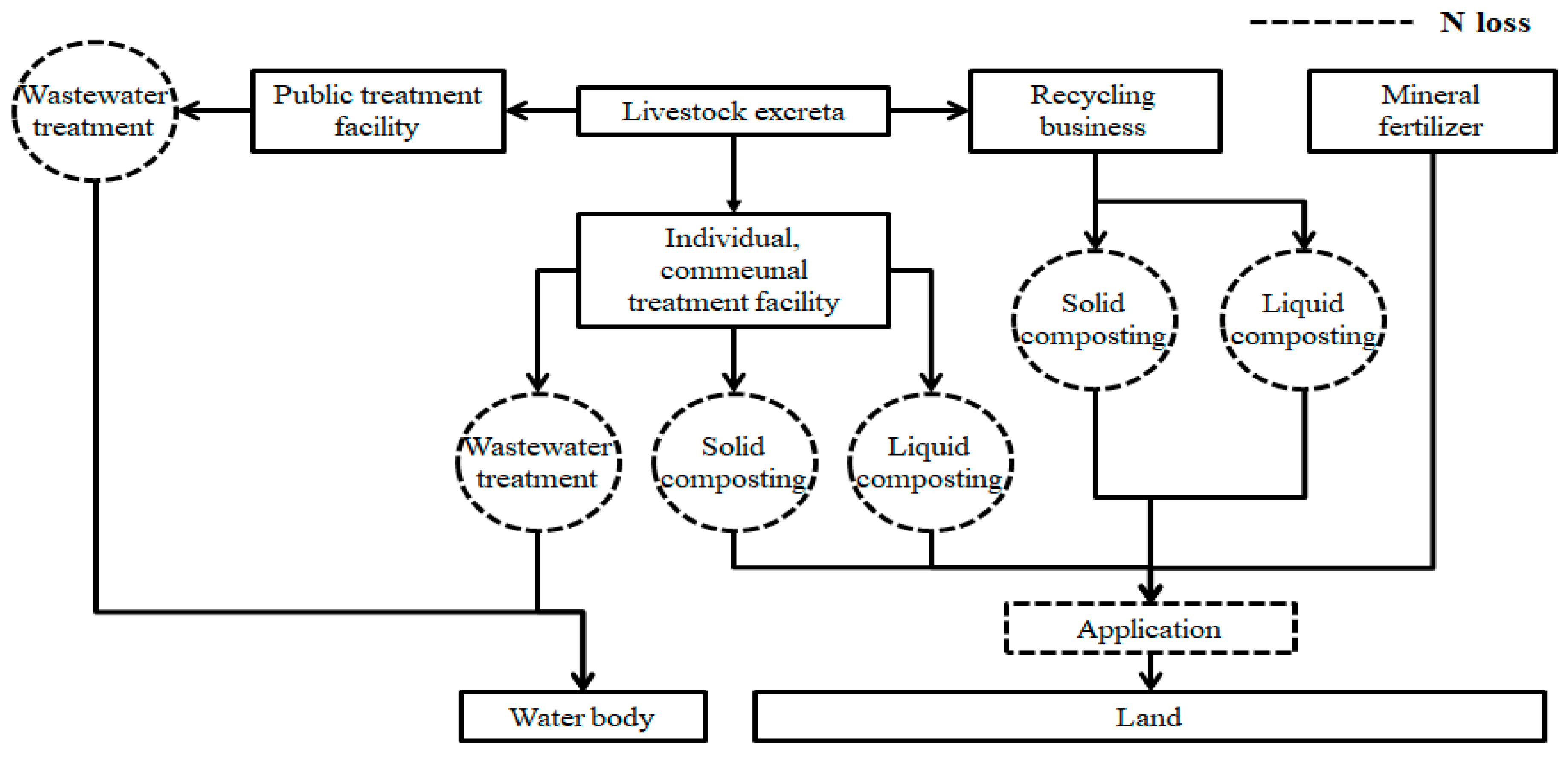

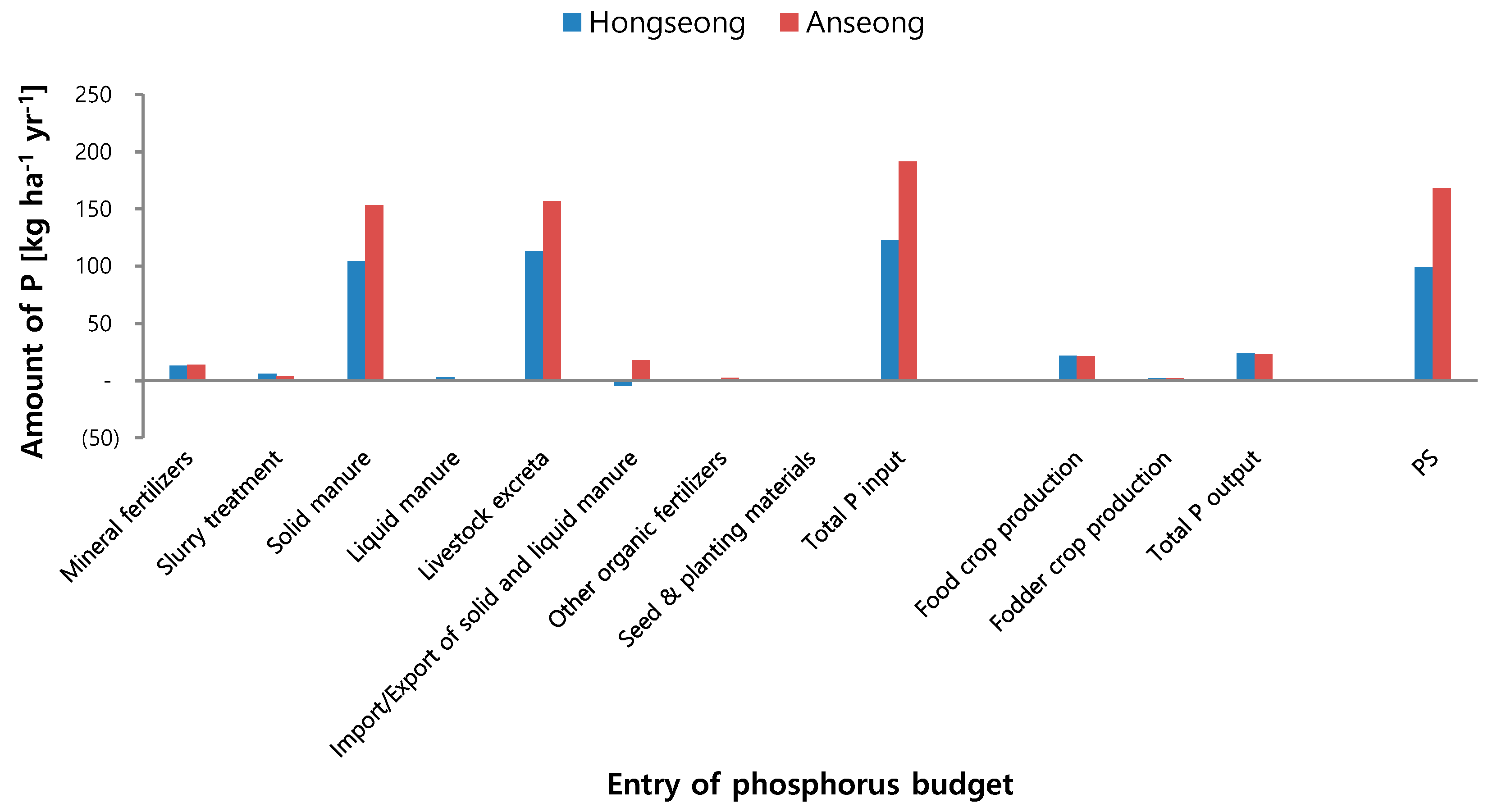
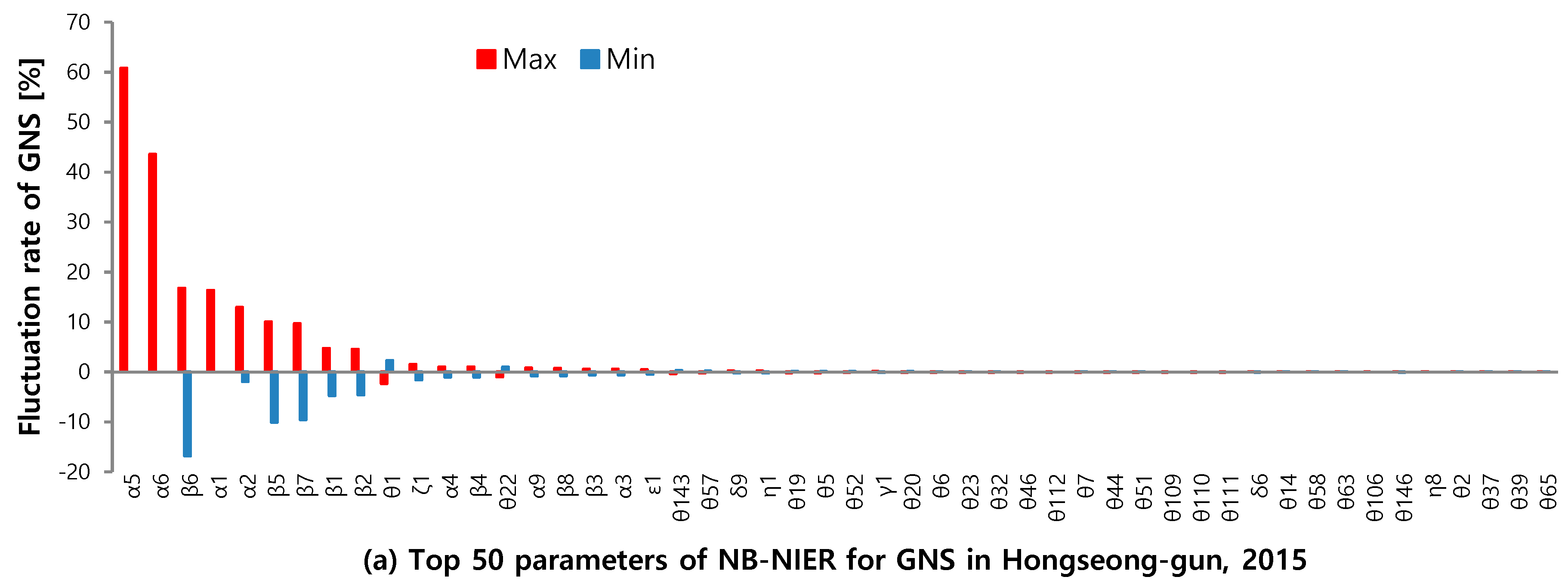
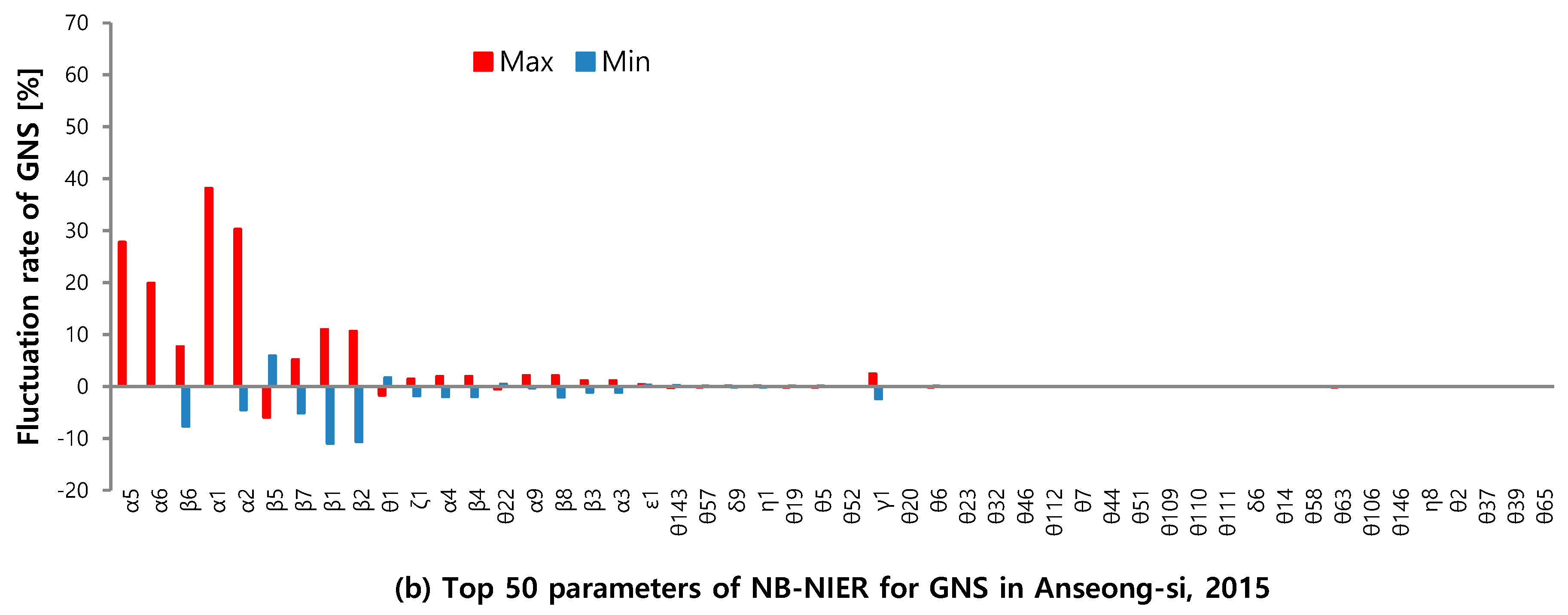
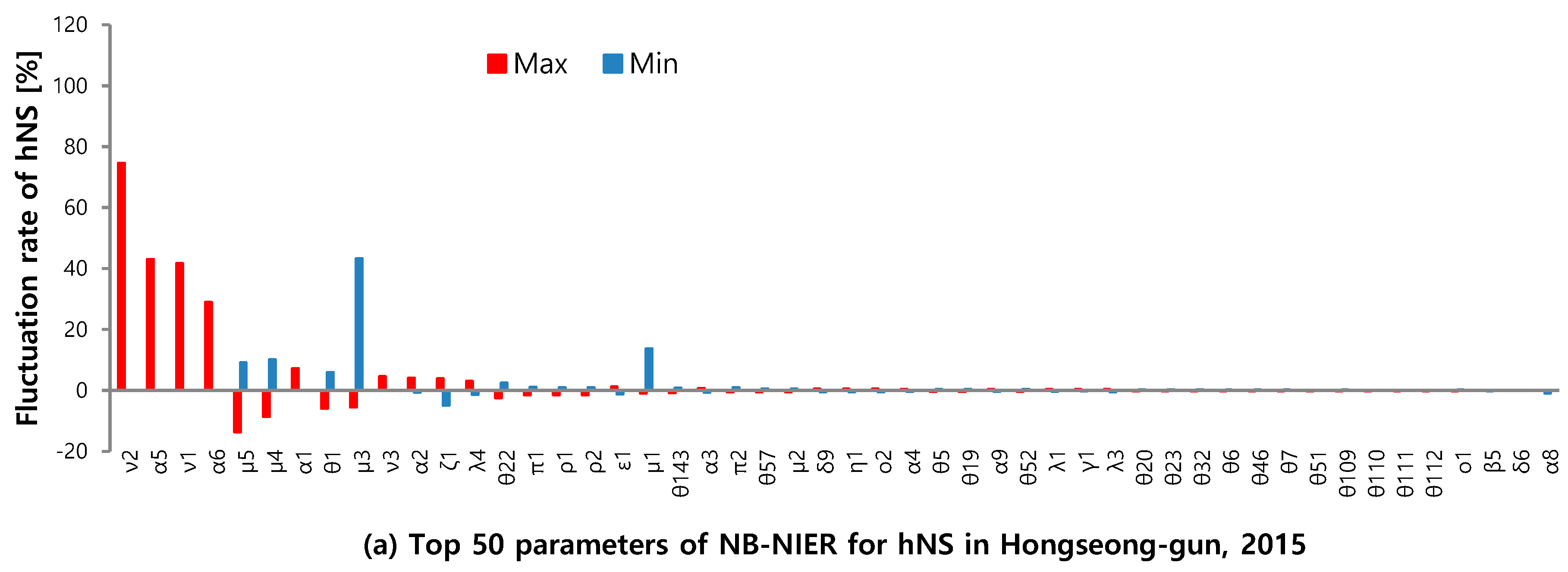
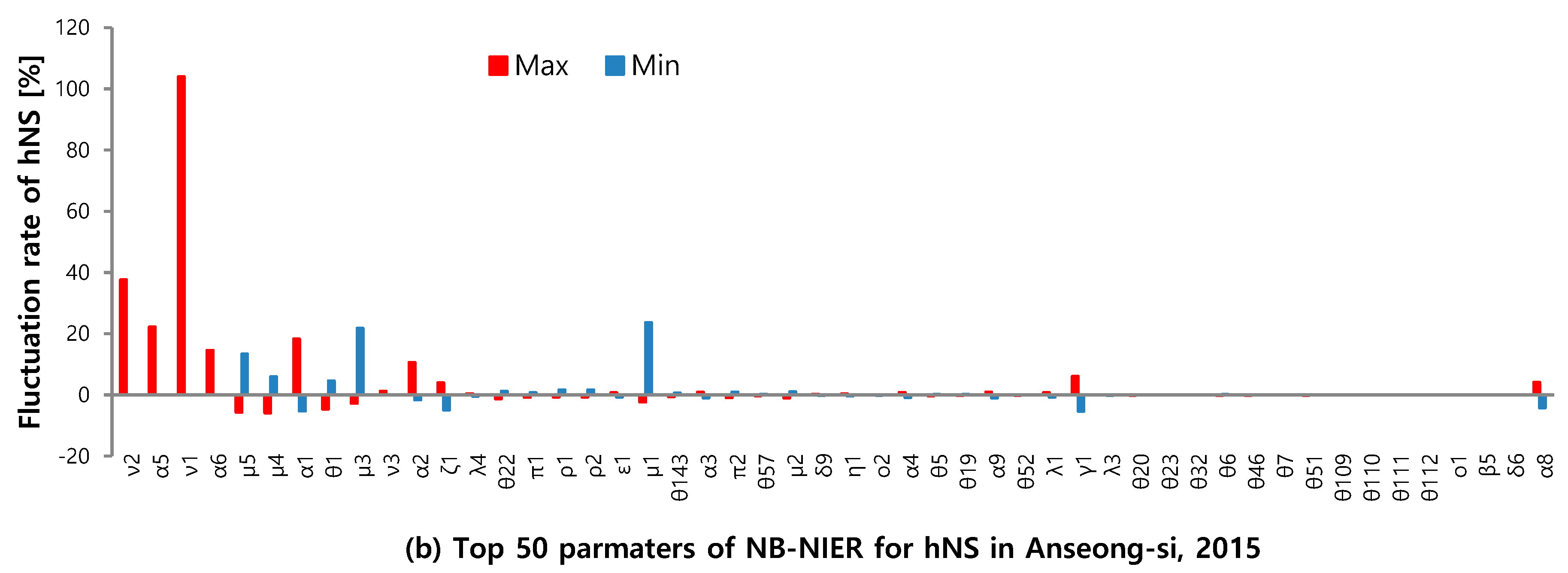
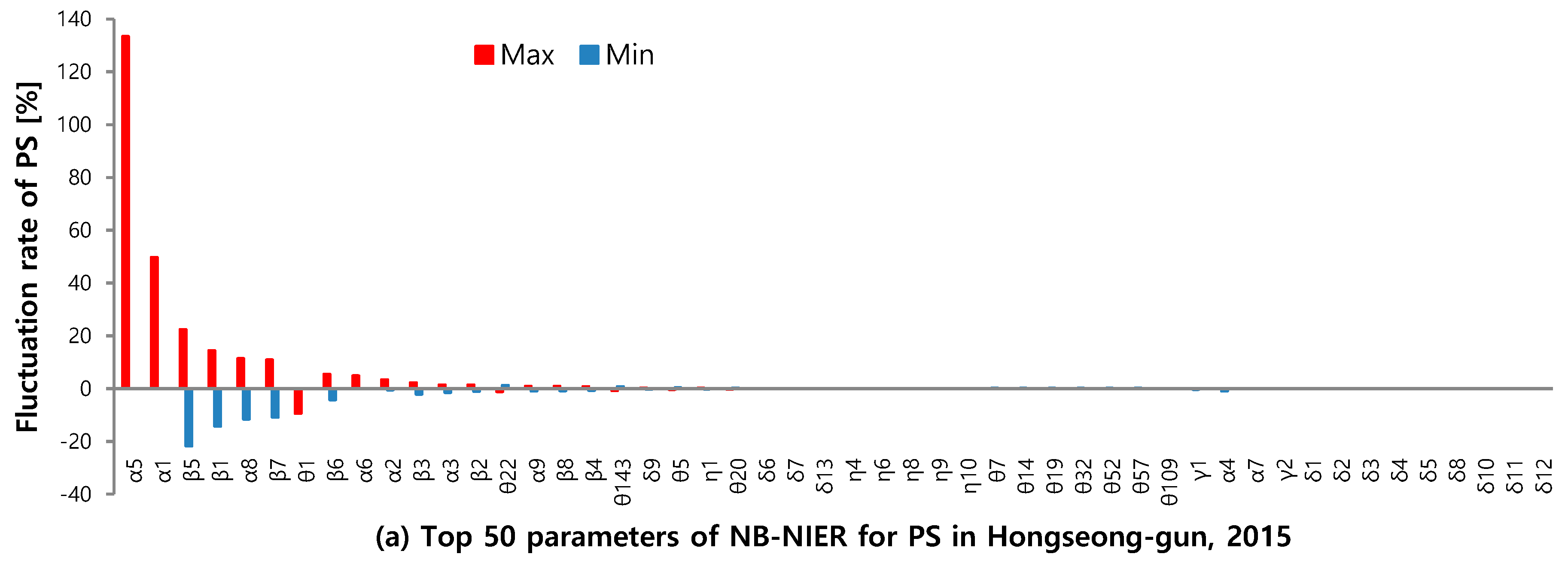
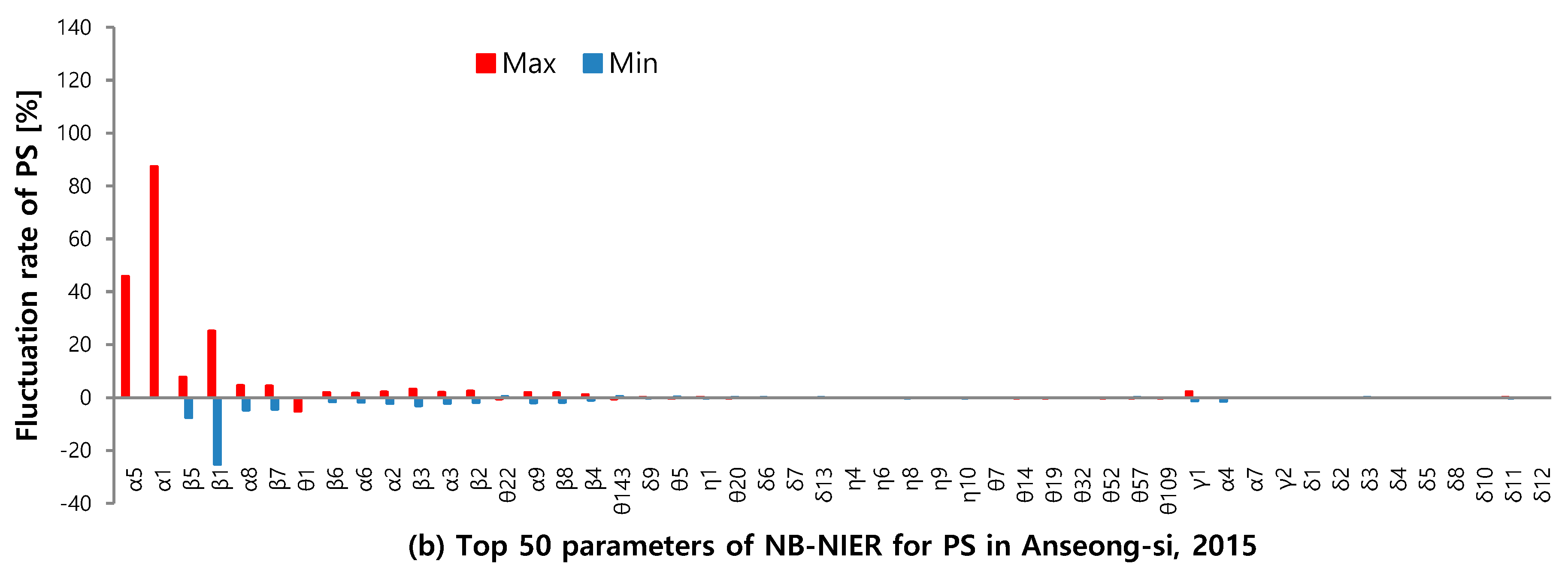
| Entry | Data | Sources |
|---|---|---|
| Import/export of solid and liquid manure | [13,14] | |
| Input | Sale of mineral fertilizer | [15] |
| Area of paddy and upland | ||
| Sale of other organic fertilizer | [16] | |
| A headcount of livestock and rate of excreta to solid and liquid manure | [17] | |
| Cultivated area of leguminous crops | [18] | |
| Cropped area of seed | ||
| Output | Cultivated area of crops | [18] |
| Cultivated area of fodder crops |
| Entry | Methodology | Ref. | |
|---|---|---|---|
| Input | N(P)1 * | ∑i [Sale of the i mineral fertilizer (ton yr−1) × N(P) content of the i mineral fertilizer (%)] | [5] |
| N(P)2-1 * | ∑i [Headcount of i livestock (animal) × Production of excreta i livestock (L (day-animal)−1) × Share from excreta to slurry treatment (%) × N(P) content of i livestock excreta (%) × 10−3(ton L−1) × 365 (d yr−1)] | ||
| N(P)2-2 * | ∑i [Headcount of i livestock (animal) × Production of excreta i livestock (L (day-animal)−1) × Share from excreta to solid manure (%) × N(P) content of i livestock excreta (%) × 10−3 (ton L−1) × 365 (d yr−1)] | ||
| N(P) 2-3 * | ∑i [Headcount of i livestock (animal) × Production of excreta i livestock (L (day-animal)−1) × Share from excreta to liquid manure (%) × N(P) content of i livestock excreta (%) × 10−3(ton L−1) × 365 (d yr−1)] | ||
| N(P)3 * | ∑ij {[Amount of import i solid manure (ton yr−1) ×N(P) content of i solid manure (%)] + [amount of import j liquid manure (ton yr−1) × N(P) content of j liquid manure (%)]} − ∑kz {[Amount of export k solid manure (ton yr−1) × N(P) content of k solid manure (%)] + [amount of export z liquid manure (ton yr−1) ×N(P) content of z liquid manure (%)]} | ||
| N(P)4 * | ∑i [Sale of the i organic fertilizer (ton yr−1) × N(P) content of the i organic fertilizer (%)] | ||
| N5 * | ∑i [Cropped area of the i legume (ha) × coefficients of biological N fixation of the i legume (kg ha−1 yr−1) × 10−3(ton kg−1)]} | [9] | |
| N6 * | ∑i [Area of paddy and upland (m2) × coefficients of atmospheric N deposition (g(m2)−1 yr−1) × 10−6(ton g−1) × 104(m2 ha−1)] | ||
| N(P)7 * | ∑i [Cropped area of i seed (ha) × coefficients of N(P) conversion of i seed(kg ha−1 yr−1) × 10−3(ton kg−1)] | ||
| N(P)8 | Total input of nitrogen = sum(N1, N2-1, N2-2, N2-3, N3, N4, N5, N6, N7) | ||
| Total input of phosphorus = sum(P1, P2-1, P2-2, P2-3, P3, P4, P7) | |||
| Output | N(P)9 * | ∑i [Cropped area of the i food crop (10a) × the standard N(P) requirements for fertilization of the i food crop (kg (10a)−1 yr−1) × 10−3(ton kg−1)] | [5] |
| N(P)10 * | ∑i [Cropped area of the i fodder crop (10a) × the standard N(P) requirements for fertilization of the i fodder crop (kg (10a)−1 yr−1) × 10−3(ton kg−1)] | ||
| N(P)11 | Total outputs = sum(N(P)9, N(P)10) | [9] | |
| Surplus | GNS *, PS | GNS = N8 − N11, PS = P8 − P11 | |
| aNS * | ∑jkz{[Amount of N loss at j swine excreta treatment plant (SETP) (ton yr−1)] + [Amount of N loss during composting at k solid compositing facility (SCF) (ton yr−1)] + [Amount of N loss during composting at z liquid compositing facility (LCF) (ton yr−1)]} + Amount of N loss during application of fertilizers + Amount of N loss during application of livestock manure compost ○ Amount of N loss at j SETP (j = Public, Individual, Communal)
| [5] | |
| hNS | hydrospheric Nitrogen Surplus(hNS) = GNS − aNS | [9] | |
| Index | Parameter | Unit | Coefficient | Max | Min | Symbol | Ref. | |||
|---|---|---|---|---|---|---|---|---|---|---|
| Production of excreta | Production of excreta in livestock | L [day-animal(d-a)]−1 | Beef cattle | feces | 8.0 | 25 | 8.0 | α1 | [19,37] | |
| urine | 5.7 | 13.8 | 4.5 | α2 | ||||||
| Dairy cow | feces | 19.2 | 28.8 ** | 9.6 *** | α3 | |||||
| urine | 10.9 | 16.35 ** | 5.45 *** | α4 | ||||||
| Swine | feces | 0.87 | 3.5 | 0.87 | α5 | |||||
| urine | 1.74 | 4.0 | 1.74 | α6 | ||||||
| Layer | feces | 0.1247 | 0.19 ** | 0.06 *** | α7 | |||||
| Broiler | feces | 0.0855 | 0.13 ** | 0.043 *** | α8 | |||||
| Duck | feces | 0.0855 | 0.13 ** | 0.043 *** | α9 | |||||
| Nutrient content in livestock excreta | % | N(P) | Beef cattle | feces | 0.5(0.26) | 0.75(0.39) ** | 0.25(0.13) *** | β1 | [20] | |
| urine | 0.68(0.03) | 1.02(0.045) ** | 0.34(0.015) *** | β2 | ||||||
| Dairy cow | feces | 0.33(0.21) | 0.5(0.32) ** | 0.17(0.105) *** | β3 | |||||
| urine | 1.02(0.12) | 1.53(0.18) ** | 1.53(0.06) *** | β4 | ||||||
| Swine | feces | 0.96(0.36) | 1.44(0.54) ** | 0.48(0.18) *** | β5 | |||||
| urine | 0.8(0.04) | 1.2(0.08) ** | 0.4(0.02) *** | β6 | ||||||
| Layer, Broiler | feces | 1.39(0.27) | 2.09(0.41) ** | 0.7(0.14) *** | β7 | |||||
| Duck | feces | 1.39(0.27) | 2.09 ** | 0.7(0.14) *** | β8 | |||||
| Manure | Nutrient content of manure | % | N(P) | Manure | Solid | 1.69(0.87) * | 2.46(1.04) | 1.01(0.77) | γ1 | [21,22,23,24] |
| liquid | 0.29(0.035) * | 0.97(0.162) | 0.02(0.004) | γ2 | [25] | |||||
| Other organic fertilizers | Nutrient content of organic fertilizer | % | N(P) | Fertilizer products (No.1) | 4.2(0.79) | 6.3(1.19) ** | 2.1(0.4) *** | δ1 | [16] | |
| Fertilizer products (No.38) | 4.0(0.87) | 6.0(1.31) ** | 2.0(0.44) *** | δ38 | ||||||
| Biological nitrogen fixation | The annual rates of biological nitrogen fixation | kg N ha−1 yr−1 | Soya bean | 77.5 * | 135 | 20 | ε1 | [9] | ||
| Adzuki beans | 74.5 * | 125 | 24 | ε2 | ||||||
| Atmospheric nitrogen deposition | Coefficients of atmospheric nitrogen deposition | g N(m2)−1 yr−1 | 2.41 * | 3.31 | 1.29 | ζ1 | [26] | |||
| Seed and planting material | Annual nutrient coefficients on seed input | kg N(P) ha−1 yr−1 | Average N(P) | Cereals | 3(0.6) | 4.5(0.9) ** | 1.5(0.3) *** | η1 | [9] | |
| Wheat | 4(0.7) | 6(1.05) ** | 2(0.35) *** | η2 | ||||||
| Barley | 3(0.6) | 4.5(0.9) ** | 1.5(0.3) *** | η3 | ||||||
| Rye | 2.7(0.6) | 4.05(0.9) ** | 1.35(0.3) *** | η4 | ||||||
| Oats | 3(0.6) | 4.5(0.9) ** | 1.5(0.3) *** | η5 | ||||||
| Grain maize | 4.4(1.1) | 6.6(1.65) ** | 2.2(0.55) *** | η6 | ||||||
| Triticale | 3.2(0.6) | 4.8(0.9) ** | 1.6(0.3) *** | η7 | ||||||
| Dried pulses | 6.2(0.8) | 9.3(1.2) ** | 3.1(0.4) *** | η8 | ||||||
| Potatoes | 8.6(1.4) | 12.9(2.1) ** | 4.3(0.7) *** | η9 | ||||||
| Oilseed crops | 0.4(0.7) | 0.6(1.05) ** | 0.2(0.35) *** | η10 | ||||||
| Crop production | Fertilizer recommendations guidelines for crops | kg N(P) (10a)−1 | N(P) | Rice | 9.0(2.0) | 11 | 7 | Θ1 | [27] | |
| Cabbage | 32(3.9) | 48(5.85) ** | 16(1.95) *** | Θ70 | ||||||
| a tea plant | 60(8.7) | 90(13.1) ** | 30(4.35) *** | Θ147 | ||||||
| Fodder Production | N(P) | Pasture grass | 21(6.5) | 31.5(9.75) ** | 10.5(3.25) *** | ι1 | ||||
| Forage corn | 21(6.5) | 31.5(9.75) ** | 10.5(3.25) *** | ι2 | ||||||
| Swine excreta treatment plant (SETP) | Effluent water quality of individual SETP | mg L−1 | TN(TP) | Permission | 250(100) | 375(150) ** | 125(50) *** | κ1 | [28] | |
| Report | 400(100) | 600(150) ** | 200(50) *** | κ2 | ||||||
| Effluent water quality of communal SETP | TN(TP) | Permission | 250(100) | 375(150) ** | 125(50) *** | κ3 | ||||
| Report | 400(100) | 600(150) ** | 200(50) *** | κ4 | ||||||
| Solid composting from livestock excreta | Amount of sawdust bedding during solid composting in Korea | kg (d-a)−1 | Beef cattle | 1.1000 | 3.84 | 0.26 | Λ1 | [29] | ||
| Dairy cow | 1.0300 | 2.11 | 0.18 | Λ2 | ||||||
| Swine | 0.0300 | 0.13 | 0.01 | Λ3 | ||||||
| Layer | 0.0173 | 0.0548 | 0.0003 | Λ4 | ||||||
| Broiler, Duck | 0.0003 | 0.000022 | 0.001058 | Λ5 | ||||||
| Weight loss percentages of livestock excreta during solid composting in Korea | % | Beef cattle | 78.5 * | 81.0 | 42.3 | μ1 | [29,30,31,32,33,34] | |||
| Dairy cow | 61.5 * | 68.0 | 55.0 | μ2 | ||||||
| Swine | 66.25 * | 69.0 | 44.5 | μ3 | ||||||
| Layer | 65.5 * | 98.25 ** | 32.75 *** | μ4 | ||||||
| Broiler, Duck | 86 | 129 ** | 43 *** | μ5 | ||||||
| Nutrient content in solid manure in Korea | % | N(P) | Beef cattle | 0.41(0.24) | 2.1(0.26) | 0.41(0.24) | ν1 | [21,22,24] | ||
| Swine | 0.90(0.65) | 1.9(0.87) | 0.90(0.65) | ν2 | ||||||
| Layer | 1.63(0.72) | 2.1 | 1.63() | ν3 | ||||||
| Liquid composting from livestock excreta | Amount of evaporation during liquid manure composting in Korea | m3 d−1 | Swine | 0.35 | 0.44 | 0.26 | ο1 | [29] | ||
| Nutrient content in liquid manure in Korea | % | N | Swine | 0.29 | 0.97 | 0.02 | ο2 | [25] | ||
| Nitrogen emission | Ammonia emission during application of fertilizers in cropland | kg NH3 (ton-N)−1 | Mineral fertilizers | Urea | 141.5 | 212.3 | 70.8 | π1 | [35] | |
| Complex | 75.2 | 112.8 | 37.6 | π2 | ||||||
| % | Manure | NH3 content | 3 | 4.5 ** | 1.5 *** | ρ1 | [36] | |||
| Loss of NH3 | 66 | 66 | 33 *** | ρ2 | ||||||
| Parameter | GNS | hNS | PS | |||||||||
|---|---|---|---|---|---|---|---|---|---|---|---|---|
| Hongseong | Anseong | Hongseong | Anseong | Hongseong | Anseong | |||||||
| Max | Min | Max | Min | Max | Min | Max | Min | Max | Min | Max | Min | |
| Production of excreta in livestock | α1 | - | α1 | - | α1 | - | α1 | α1 | α1 | - | α1 | - |
| α2 | - | α2 | α2 | α2 | - | α2 | - | α2 | - | α2 | α2 | |
| - | - | - | - | - | - | - | - | - | - | - | α3 | |
| α5 | - | α5 | - | α5 | - | α5 | - | α5 | - | α5 | - | |
| α6 | - | α6 | - | α6 | - | α6 | - | α6 | - | - | - | |
| - | - | - | - | - | - | α8 | α8 | α8 | α8 | α8 | α8 | |
| - | - | α9 | - | - | - | - | - | - | - | - | - | |
| Nutrient content in livestock excreta | β1 | β1 | β1 | β1 | - | - | - | - | β1 | β1 | β1 | β1 |
| β2 | β2 | β2 | β2 | - | - | - | - | - | - | β2 | - | |
| - | - | - | - | - | - | - | - | β3 | β3 | β3 | β3 | |
| β5 | β5 | β5 | β5 | - | - | - | - | β5 | β5 | β5 | β5 | |
| β6 | β6 | β6 | β6 | - | - | - | - | β6 | β6 | - | - | |
| β7 | β7 | β7 | β7 | - | - | - | - | β7 | β7 | β7 | β7 | |
| - | - | β8 | β8 | - | - | - | - | - | - | - | - | |
| Nutrient content of manure | - | - | γ1 | γ1 | - | - | γ1 | γ1 | - | - | γ1 | - |
| Coefficients of atmospheric nitrogen deposition | - | - | - | - | ζ1 | ζ1 | ζ1 | ζ1 | - | - | - | - |
| Fertilizer recommendations guidelines for crops | θ1 | θ1 | - | - | θ1 | θ1 | θ1 | θ1 | θ1 | - | θ1 | - |
| - | - | - | - | θ22 | θ22 | - | - | - | - | - | - | |
| - | - | - | - | - | - | θ101 | θ101 | - | - | θ101 | - | |
| Amount of sawdust bedding during solid composting in Korea | - | - | - | λ4 | - | - | - | - | - | - | - | |
| Weight loss percentages of livestock excreta during solid composting in Korea | - | - | - | - | - | μ1 | μ1 | μ1 | - | - | - | - |
| - | - | - | - | μ3 | μ3 | μ3 | μ3 | - | - | - | - | |
| - | - | - | - | μ4 | μ4 | - | μ4 | - | - | - | - | |
| - | - | - | - | μ5 | μ5 | μ5 | μ5 | - | - | - | - | |
| Nutrient content in solid manure in Korea | - | - | - | - | ν1 | - | ν1 | - | - | - | - | - |
| - | - | - | - | ν2 | - | ν2 | - | - | - | - | - | |
| - | - | - | - | ν3 | - | - | - | - | - | - | - | |
© 2019 by the authors. Licensee MDPI, Basel, Switzerland. This article is an open access article distributed under the terms and conditions of the Creative Commons Attribution (CC BY) license (http://creativecommons.org/licenses/by/4.0/).
Share and Cite
Lim, D.Y.; Ryu, H.-D.; Chung, E.G.; Shin, D.; Lee, J.K. Sensitivity Analysis of a Regional Nutrient Budget Model for Two Regions with Intensive Livestock Farming in Korea. Sustainability 2019, 11, 3676. https://doi.org/10.3390/su11133676
Lim DY, Ryu H-D, Chung EG, Shin D, Lee JK. Sensitivity Analysis of a Regional Nutrient Budget Model for Two Regions with Intensive Livestock Farming in Korea. Sustainability. 2019; 11(13):3676. https://doi.org/10.3390/su11133676
Chicago/Turabian StyleLim, Do Young, Hong-Duck Ryu, Eu Gene Chung, Dongseok Shin, and Jae Kwan Lee. 2019. "Sensitivity Analysis of a Regional Nutrient Budget Model for Two Regions with Intensive Livestock Farming in Korea" Sustainability 11, no. 13: 3676. https://doi.org/10.3390/su11133676
APA StyleLim, D. Y., Ryu, H.-D., Chung, E. G., Shin, D., & Lee, J. K. (2019). Sensitivity Analysis of a Regional Nutrient Budget Model for Two Regions with Intensive Livestock Farming in Korea. Sustainability, 11(13), 3676. https://doi.org/10.3390/su11133676






